Risk Factors in Diseases
VerifiedAdded on 2023/01/13
|17
|4553
|61
AI Summary
This article discusses the risk factors for non-communicable diseases, with a focus on diabetes. It explores the impact of physical inactivity, unhealthy diet, and other factors on the development of diabetes. The article also highlights the importance of exercise and healthy eating in preventing diabetes and other chronic illnesses. The implications of these risk factors and preventive measures are discussed in the context of the Australian National Diabetes Strategy.
Contribute Materials
Your contribution can guide someone’s learning journey. Share your
documents today.
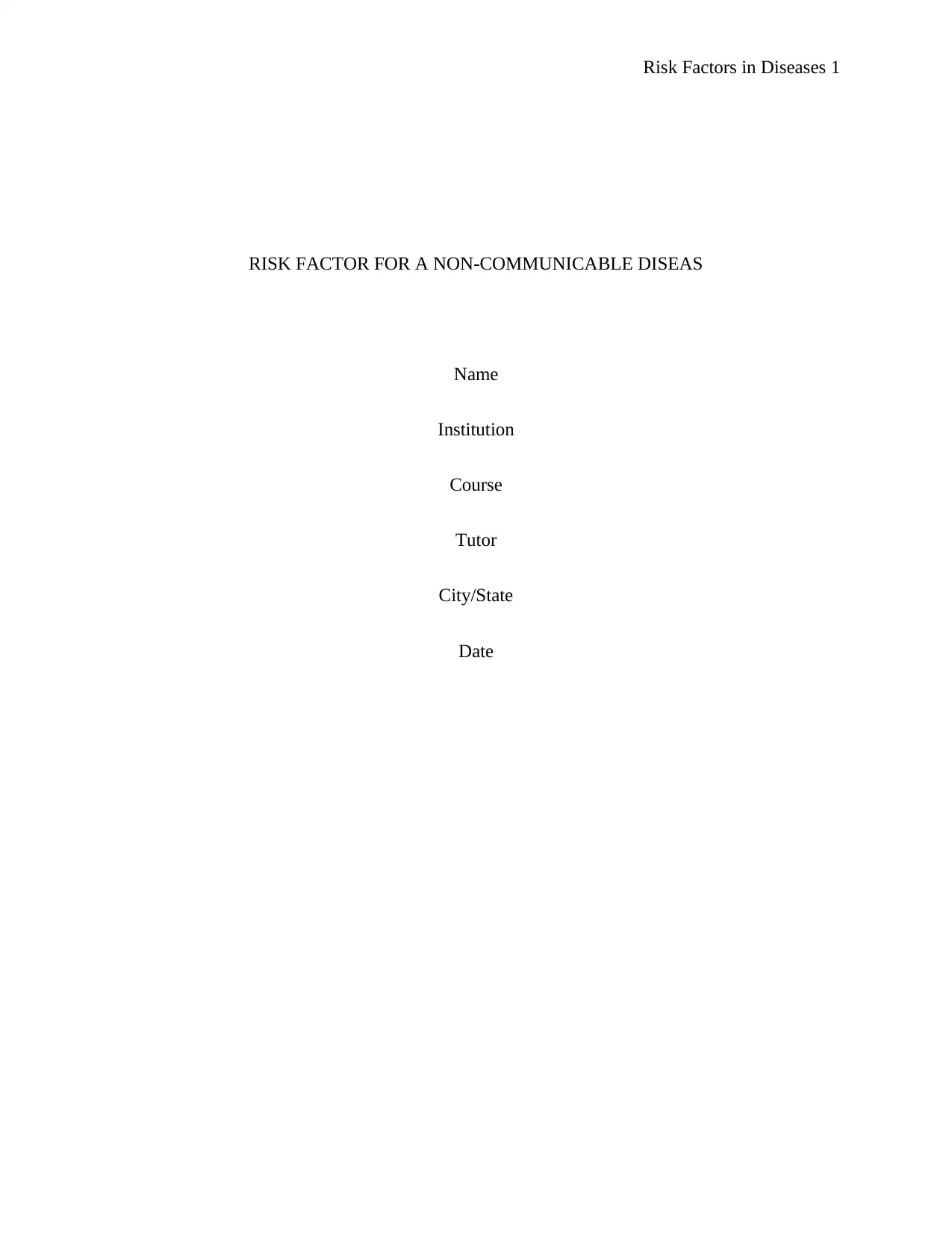
Risk Factors in Diseases 1
RISK FACTOR FOR A NON-COMMUNICABLE DISEAS
Name
Institution
Course
Tutor
City/State
Date
RISK FACTOR FOR A NON-COMMUNICABLE DISEAS
Name
Institution
Course
Tutor
City/State
Date
Secure Best Marks with AI Grader
Need help grading? Try our AI Grader for instant feedback on your assignments.
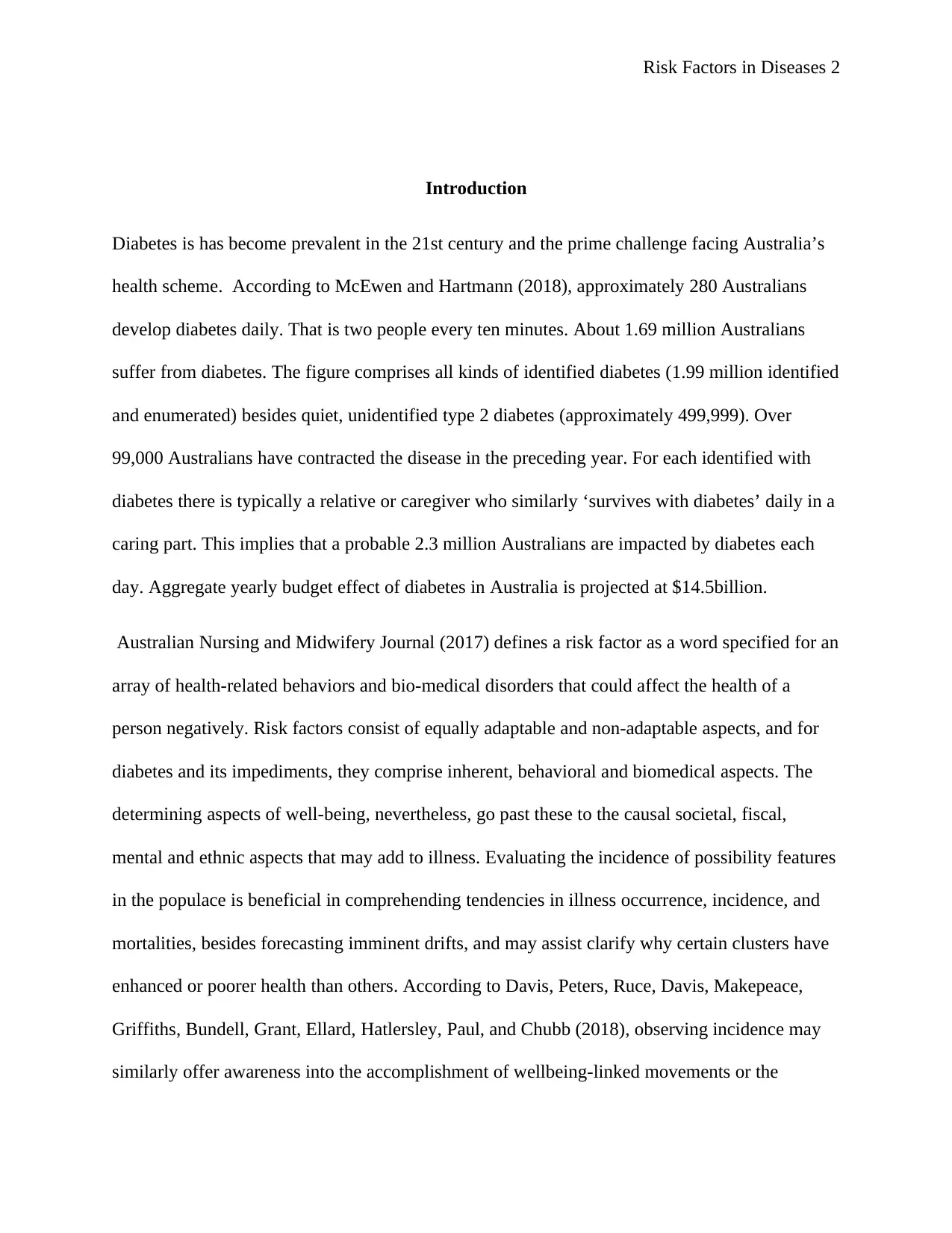
Risk Factors in Diseases 2
Introduction
Diabetes is has become prevalent in the 21st century and the prime challenge facing Australia’s
health scheme. According to McEwen and Hartmann (2018), approximately 280 Australians
develop diabetes daily. That is two people every ten minutes. About 1.69 million Australians
suffer from diabetes. The figure comprises all kinds of identified diabetes (1.99 million identified
and enumerated) besides quiet, unidentified type 2 diabetes (approximately 499,999). Over
99,000 Australians have contracted the disease in the preceding year. For each identified with
diabetes there is typically a relative or caregiver who similarly ‘survives with diabetes’ daily in a
caring part. This implies that a probable 2.3 million Australians are impacted by diabetes each
day. Aggregate yearly budget effect of diabetes in Australia is projected at $14.5billion.
Australian Nursing and Midwifery Journal (2017) defines a risk factor as a word specified for an
array of health-related behaviors and bio-medical disorders that could affect the health of a
person negatively. Risk factors consist of equally adaptable and non-adaptable aspects, and for
diabetes and its impediments, they comprise inherent, behavioral and biomedical aspects. The
determining aspects of well-being, nevertheless, go past these to the causal societal, fiscal,
mental and ethnic aspects that may add to illness. Evaluating the incidence of possibility features
in the populace is beneficial in comprehending tendencies in illness occurrence, incidence, and
mortalities, besides forecasting imminent drifts, and may assist clarify why certain clusters have
enhanced or poorer health than others. According to Davis, Peters, Ruce, Davis, Makepeace,
Griffiths, Bundell, Grant, Ellard, Hatlersley, Paul, and Chubb (2018), observing incidence may
similarly offer awareness into the accomplishment of wellbeing-linked movements or the
Introduction
Diabetes is has become prevalent in the 21st century and the prime challenge facing Australia’s
health scheme. According to McEwen and Hartmann (2018), approximately 280 Australians
develop diabetes daily. That is two people every ten minutes. About 1.69 million Australians
suffer from diabetes. The figure comprises all kinds of identified diabetes (1.99 million identified
and enumerated) besides quiet, unidentified type 2 diabetes (approximately 499,999). Over
99,000 Australians have contracted the disease in the preceding year. For each identified with
diabetes there is typically a relative or caregiver who similarly ‘survives with diabetes’ daily in a
caring part. This implies that a probable 2.3 million Australians are impacted by diabetes each
day. Aggregate yearly budget effect of diabetes in Australia is projected at $14.5billion.
Australian Nursing and Midwifery Journal (2017) defines a risk factor as a word specified for an
array of health-related behaviors and bio-medical disorders that could affect the health of a
person negatively. Risk factors consist of equally adaptable and non-adaptable aspects, and for
diabetes and its impediments, they comprise inherent, behavioral and biomedical aspects. The
determining aspects of well-being, nevertheless, go past these to the causal societal, fiscal,
mental and ethnic aspects that may add to illness. Evaluating the incidence of possibility features
in the populace is beneficial in comprehending tendencies in illness occurrence, incidence, and
mortalities, besides forecasting imminent drifts, and may assist clarify why certain clusters have
enhanced or poorer health than others. According to Davis, Peters, Ruce, Davis, Makepeace,
Griffiths, Bundell, Grant, Ellard, Hatlersley, Paul, and Chubb (2018), observing incidence may
similarly offer awareness into the accomplishment of wellbeing-linked movements or the
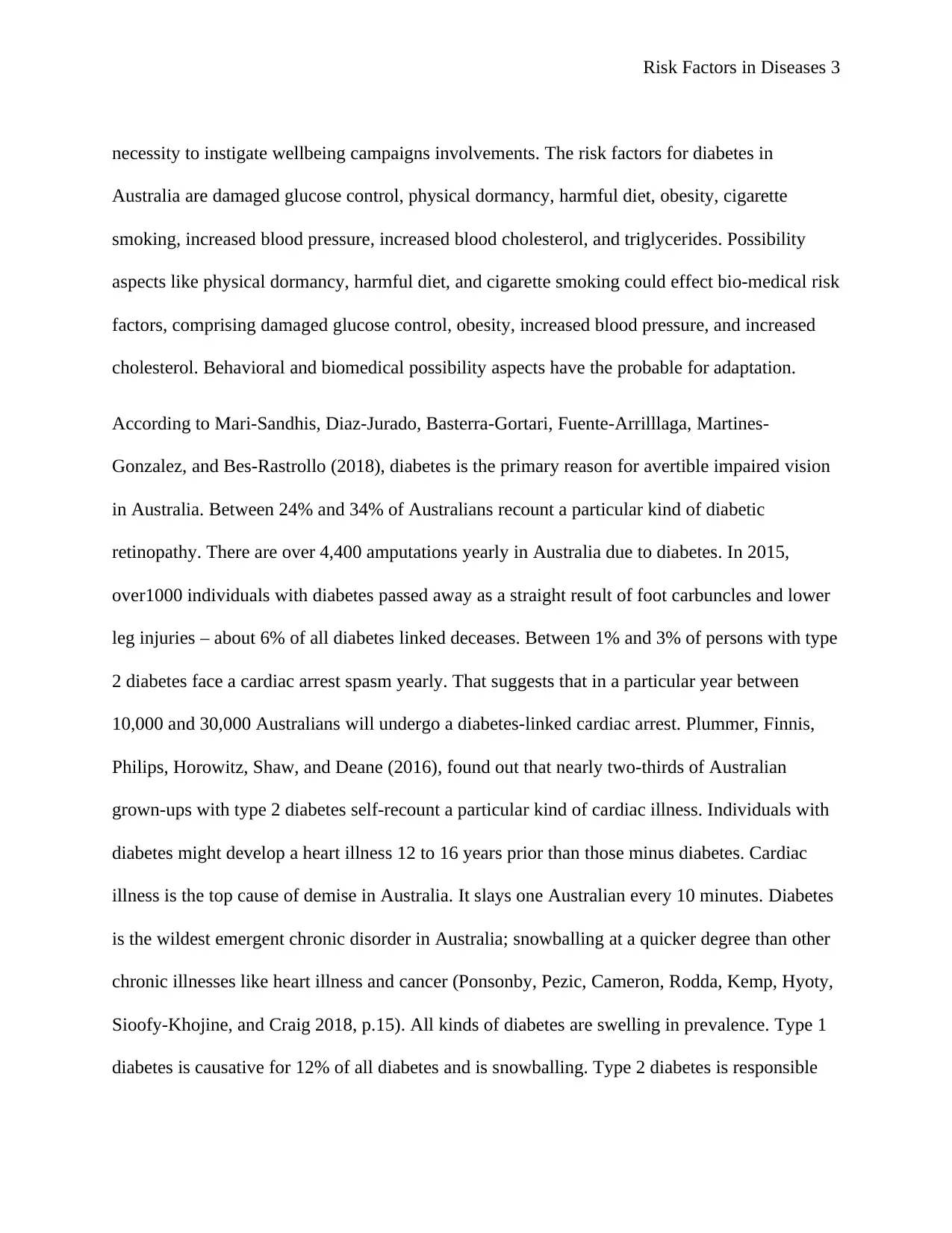
Risk Factors in Diseases 3
necessity to instigate wellbeing campaigns involvements. The risk factors for diabetes in
Australia are damaged glucose control, physical dormancy, harmful diet, obesity, cigarette
smoking, increased blood pressure, increased blood cholesterol, and triglycerides. Possibility
aspects like physical dormancy, harmful diet, and cigarette smoking could effect bio-medical risk
factors, comprising damaged glucose control, obesity, increased blood pressure, and increased
cholesterol. Behavioral and biomedical possibility aspects have the probable for adaptation.
According to Mari-Sandhis, Diaz-Jurado, Basterra-Gortari, Fuente-Arrilllaga, Martines-
Gonzalez, and Bes-Rastrollo (2018), diabetes is the primary reason for avertible impaired vision
in Australia. Between 24% and 34% of Australians recount a particular kind of diabetic
retinopathy. There are over 4,400 amputations yearly in Australia due to diabetes. In 2015,
over1000 individuals with diabetes passed away as a straight result of foot carbuncles and lower
leg injuries – about 6% of all diabetes linked deceases. Between 1% and 3% of persons with type
2 diabetes face a cardiac arrest spasm yearly. That suggests that in a particular year between
10,000 and 30,000 Australians will undergo a diabetes-linked cardiac arrest. Plummer, Finnis,
Philips, Horowitz, Shaw, and Deane (2016), found out that nearly two-thirds of Australian
grown-ups with type 2 diabetes self-recount a particular kind of cardiac illness. Individuals with
diabetes might develop a heart illness 12 to 16 years prior than those minus diabetes. Cardiac
illness is the top cause of demise in Australia. It slays one Australian every 10 minutes. Diabetes
is the wildest emergent chronic disorder in Australia; snowballing at a quicker degree than other
chronic illnesses like heart illness and cancer (Ponsonby, Pezic, Cameron, Rodda, Kemp, Hyoty,
Sioofy-Khojine, and Craig 2018, p.15). All kinds of diabetes are swelling in prevalence. Type 1
diabetes is causative for 12% of all diabetes and is snowballing. Type 2 diabetes is responsible
necessity to instigate wellbeing campaigns involvements. The risk factors for diabetes in
Australia are damaged glucose control, physical dormancy, harmful diet, obesity, cigarette
smoking, increased blood pressure, increased blood cholesterol, and triglycerides. Possibility
aspects like physical dormancy, harmful diet, and cigarette smoking could effect bio-medical risk
factors, comprising damaged glucose control, obesity, increased blood pressure, and increased
cholesterol. Behavioral and biomedical possibility aspects have the probable for adaptation.
According to Mari-Sandhis, Diaz-Jurado, Basterra-Gortari, Fuente-Arrilllaga, Martines-
Gonzalez, and Bes-Rastrollo (2018), diabetes is the primary reason for avertible impaired vision
in Australia. Between 24% and 34% of Australians recount a particular kind of diabetic
retinopathy. There are over 4,400 amputations yearly in Australia due to diabetes. In 2015,
over1000 individuals with diabetes passed away as a straight result of foot carbuncles and lower
leg injuries – about 6% of all diabetes linked deceases. Between 1% and 3% of persons with type
2 diabetes face a cardiac arrest spasm yearly. That suggests that in a particular year between
10,000 and 30,000 Australians will undergo a diabetes-linked cardiac arrest. Plummer, Finnis,
Philips, Horowitz, Shaw, and Deane (2016), found out that nearly two-thirds of Australian
grown-ups with type 2 diabetes self-recount a particular kind of cardiac illness. Individuals with
diabetes might develop a heart illness 12 to 16 years prior than those minus diabetes. Cardiac
illness is the top cause of demise in Australia. It slays one Australian every 10 minutes. Diabetes
is the wildest emergent chronic disorder in Australia; snowballing at a quicker degree than other
chronic illnesses like heart illness and cancer (Ponsonby, Pezic, Cameron, Rodda, Kemp, Hyoty,
Sioofy-Khojine, and Craig 2018, p.15). All kinds of diabetes are swelling in prevalence. Type 1
diabetes is causative for 12% of all diabetes and is snowballing. Type 2 diabetes is responsible
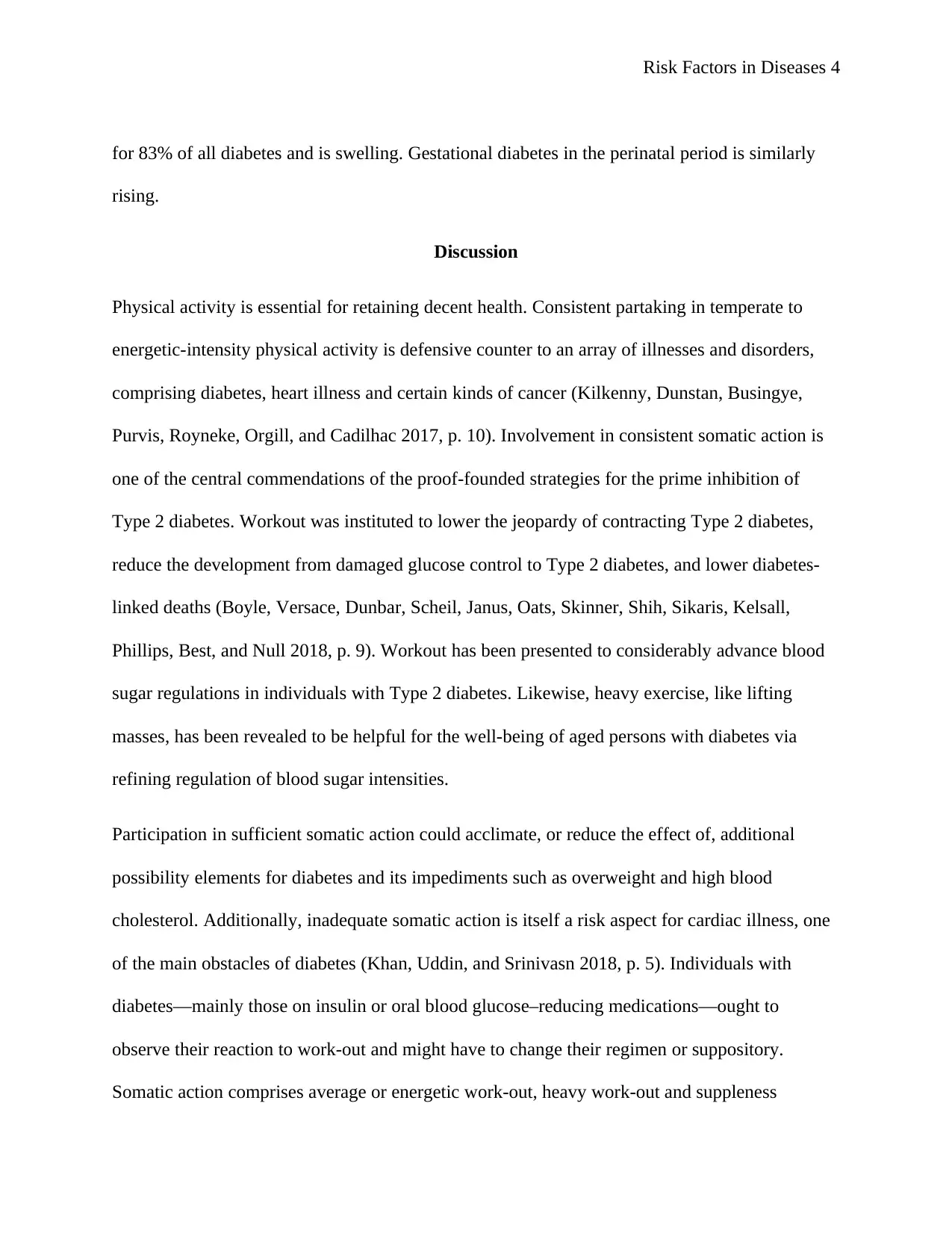
Risk Factors in Diseases 4
for 83% of all diabetes and is swelling. Gestational diabetes in the perinatal period is similarly
rising.
Discussion
Physical activity is essential for retaining decent health. Consistent partaking in temperate to
energetic-intensity physical activity is defensive counter to an array of illnesses and disorders,
comprising diabetes, heart illness and certain kinds of cancer (Kilkenny, Dunstan, Busingye,
Purvis, Royneke, Orgill, and Cadilhac 2017, p. 10). Involvement in consistent somatic action is
one of the central commendations of the proof-founded strategies for the prime inhibition of
Type 2 diabetes. Workout was instituted to lower the jeopardy of contracting Type 2 diabetes,
reduce the development from damaged glucose control to Type 2 diabetes, and lower diabetes-
linked deaths (Boyle, Versace, Dunbar, Scheil, Janus, Oats, Skinner, Shih, Sikaris, Kelsall,
Phillips, Best, and Null 2018, p. 9). Workout has been presented to considerably advance blood
sugar regulations in individuals with Type 2 diabetes. Likewise, heavy exercise, like lifting
masses, has been revealed to be helpful for the well-being of aged persons with diabetes via
refining regulation of blood sugar intensities.
Participation in sufficient somatic action could acclimate, or reduce the effect of, additional
possibility elements for diabetes and its impediments such as overweight and high blood
cholesterol. Additionally, inadequate somatic action is itself a risk aspect for cardiac illness, one
of the main obstacles of diabetes (Khan, Uddin, and Srinivasn 2018, p. 5). Individuals with
diabetes—mainly those on insulin or oral blood glucose–reducing medications—ought to
observe their reaction to work-out and might have to change their regimen or suppository.
Somatic action comprises average or energetic work-out, heavy work-out and suppleness
for 83% of all diabetes and is swelling. Gestational diabetes in the perinatal period is similarly
rising.
Discussion
Physical activity is essential for retaining decent health. Consistent partaking in temperate to
energetic-intensity physical activity is defensive counter to an array of illnesses and disorders,
comprising diabetes, heart illness and certain kinds of cancer (Kilkenny, Dunstan, Busingye,
Purvis, Royneke, Orgill, and Cadilhac 2017, p. 10). Involvement in consistent somatic action is
one of the central commendations of the proof-founded strategies for the prime inhibition of
Type 2 diabetes. Workout was instituted to lower the jeopardy of contracting Type 2 diabetes,
reduce the development from damaged glucose control to Type 2 diabetes, and lower diabetes-
linked deaths (Boyle, Versace, Dunbar, Scheil, Janus, Oats, Skinner, Shih, Sikaris, Kelsall,
Phillips, Best, and Null 2018, p. 9). Workout has been presented to considerably advance blood
sugar regulations in individuals with Type 2 diabetes. Likewise, heavy exercise, like lifting
masses, has been revealed to be helpful for the well-being of aged persons with diabetes via
refining regulation of blood sugar intensities.
Participation in sufficient somatic action could acclimate, or reduce the effect of, additional
possibility elements for diabetes and its impediments such as overweight and high blood
cholesterol. Additionally, inadequate somatic action is itself a risk aspect for cardiac illness, one
of the main obstacles of diabetes (Khan, Uddin, and Srinivasn 2018, p. 5). Individuals with
diabetes—mainly those on insulin or oral blood glucose–reducing medications—ought to
observe their reaction to work-out and might have to change their regimen or suppository.
Somatic action comprises average or energetic work-out, heavy work-out and suppleness
Secure Best Marks with AI Grader
Need help grading? Try our AI Grader for instant feedback on your assignments.
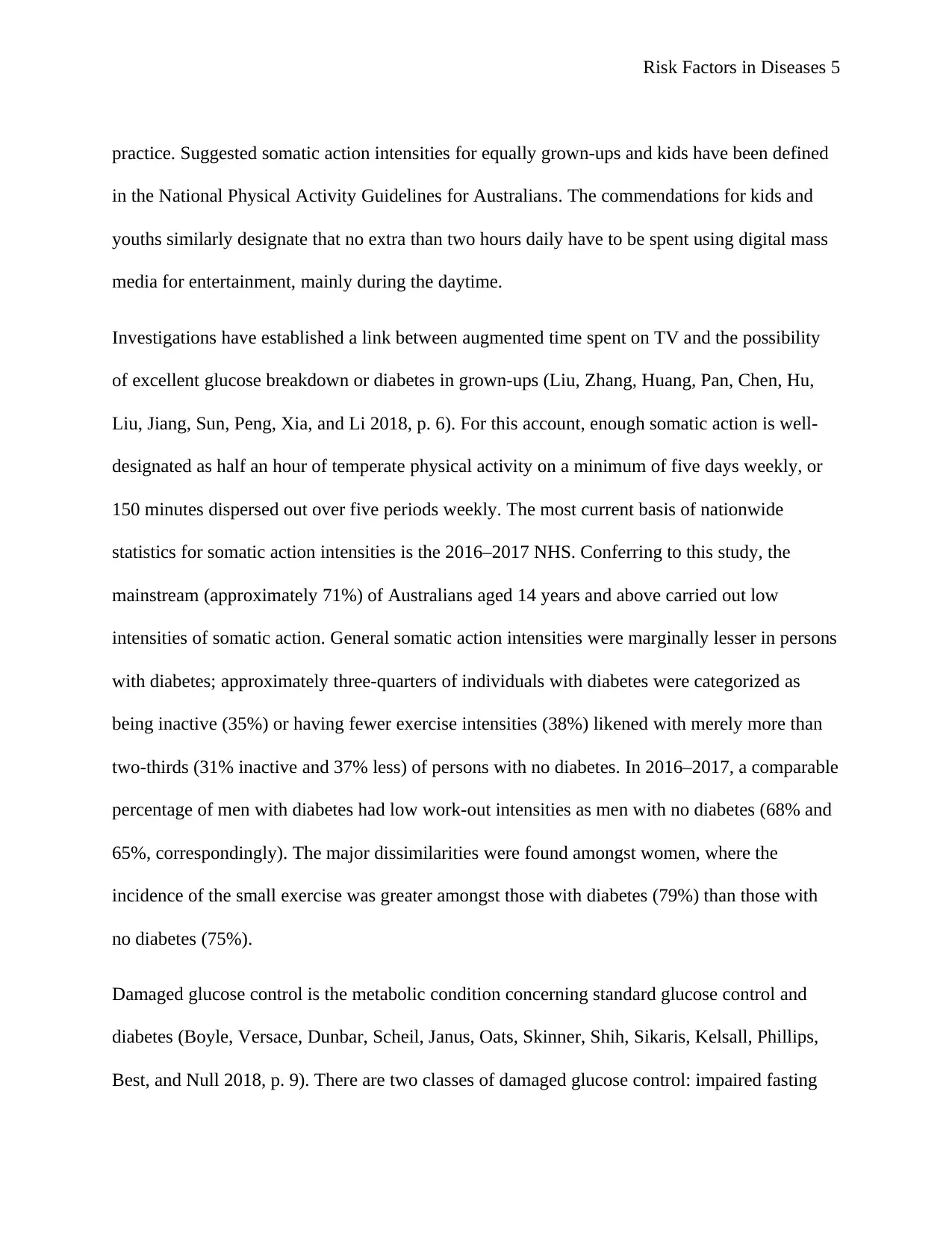
Risk Factors in Diseases 5
practice. Suggested somatic action intensities for equally grown-ups and kids have been defined
in the National Physical Activity Guidelines for Australians. The commendations for kids and
youths similarly designate that no extra than two hours daily have to be spent using digital mass
media for entertainment, mainly during the daytime.
Investigations have established a link between augmented time spent on TV and the possibility
of excellent glucose breakdown or diabetes in grown-ups (Liu, Zhang, Huang, Pan, Chen, Hu,
Liu, Jiang, Sun, Peng, Xia, and Li 2018, p. 6). For this account, enough somatic action is well-
designated as half an hour of temperate physical activity on a minimum of five days weekly, or
150 minutes dispersed out over five periods weekly. The most current basis of nationwide
statistics for somatic action intensities is the 2016–2017 NHS. Conferring to this study, the
mainstream (approximately 71%) of Australians aged 14 years and above carried out low
intensities of somatic action. General somatic action intensities were marginally lesser in persons
with diabetes; approximately three-quarters of individuals with diabetes were categorized as
being inactive (35%) or having fewer exercise intensities (38%) likened with merely more than
two-thirds (31% inactive and 37% less) of persons with no diabetes. In 2016–2017, a comparable
percentage of men with diabetes had low work-out intensities as men with no diabetes (68% and
65%, correspondingly). The major dissimilarities were found amongst women, where the
incidence of the small exercise was greater amongst those with diabetes (79%) than those with
no diabetes (75%).
Damaged glucose control is the metabolic condition concerning standard glucose control and
diabetes (Boyle, Versace, Dunbar, Scheil, Janus, Oats, Skinner, Shih, Sikaris, Kelsall, Phillips,
Best, and Null 2018, p. 9). There are two classes of damaged glucose control: impaired fasting
practice. Suggested somatic action intensities for equally grown-ups and kids have been defined
in the National Physical Activity Guidelines for Australians. The commendations for kids and
youths similarly designate that no extra than two hours daily have to be spent using digital mass
media for entertainment, mainly during the daytime.
Investigations have established a link between augmented time spent on TV and the possibility
of excellent glucose breakdown or diabetes in grown-ups (Liu, Zhang, Huang, Pan, Chen, Hu,
Liu, Jiang, Sun, Peng, Xia, and Li 2018, p. 6). For this account, enough somatic action is well-
designated as half an hour of temperate physical activity on a minimum of five days weekly, or
150 minutes dispersed out over five periods weekly. The most current basis of nationwide
statistics for somatic action intensities is the 2016–2017 NHS. Conferring to this study, the
mainstream (approximately 71%) of Australians aged 14 years and above carried out low
intensities of somatic action. General somatic action intensities were marginally lesser in persons
with diabetes; approximately three-quarters of individuals with diabetes were categorized as
being inactive (35%) or having fewer exercise intensities (38%) likened with merely more than
two-thirds (31% inactive and 37% less) of persons with no diabetes. In 2016–2017, a comparable
percentage of men with diabetes had low work-out intensities as men with no diabetes (68% and
65%, correspondingly). The major dissimilarities were found amongst women, where the
incidence of the small exercise was greater amongst those with diabetes (79%) than those with
no diabetes (75%).
Damaged glucose control is the metabolic condition concerning standard glucose control and
diabetes (Boyle, Versace, Dunbar, Scheil, Janus, Oats, Skinner, Shih, Sikaris, Kelsall, Phillips,
Best, and Null 2018, p. 9). There are two classes of damaged glucose control: impaired fasting
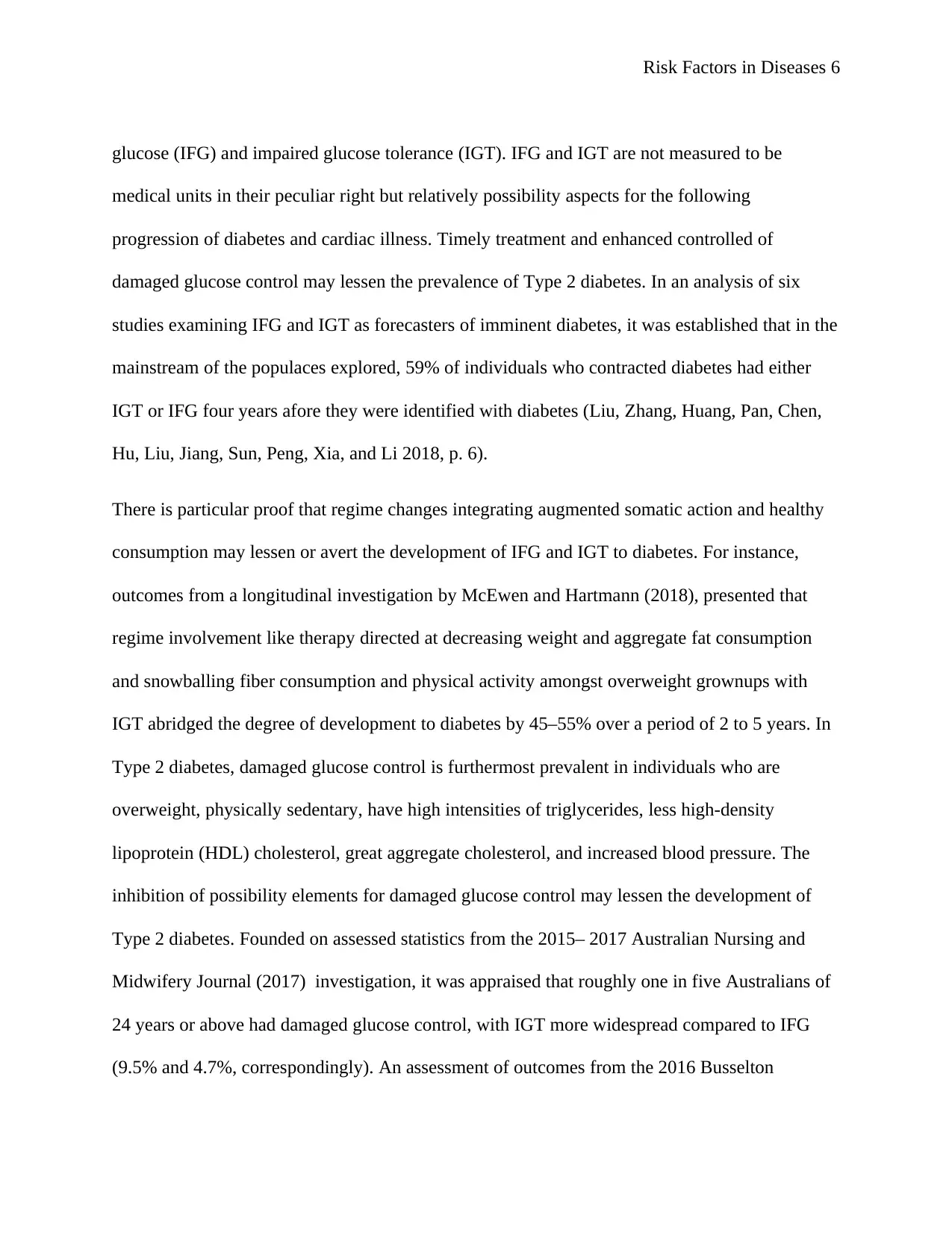
Risk Factors in Diseases 6
glucose (IFG) and impaired glucose tolerance (IGT). IFG and IGT are not measured to be
medical units in their peculiar right but relatively possibility aspects for the following
progression of diabetes and cardiac illness. Timely treatment and enhanced controlled of
damaged glucose control may lessen the prevalence of Type 2 diabetes. In an analysis of six
studies examining IFG and IGT as forecasters of imminent diabetes, it was established that in the
mainstream of the populaces explored, 59% of individuals who contracted diabetes had either
IGT or IFG four years afore they were identified with diabetes (Liu, Zhang, Huang, Pan, Chen,
Hu, Liu, Jiang, Sun, Peng, Xia, and Li 2018, p. 6).
There is particular proof that regime changes integrating augmented somatic action and healthy
consumption may lessen or avert the development of IFG and IGT to diabetes. For instance,
outcomes from a longitudinal investigation by McEwen and Hartmann (2018), presented that
regime involvement like therapy directed at decreasing weight and aggregate fat consumption
and snowballing fiber consumption and physical activity amongst overweight grownups with
IGT abridged the degree of development to diabetes by 45–55% over a period of 2 to 5 years. In
Type 2 diabetes, damaged glucose control is furthermost prevalent in individuals who are
overweight, physically sedentary, have high intensities of triglycerides, less high-density
lipoprotein (HDL) cholesterol, great aggregate cholesterol, and increased blood pressure. The
inhibition of possibility elements for damaged glucose control may lessen the development of
Type 2 diabetes. Founded on assessed statistics from the 2015– 2017 Australian Nursing and
Midwifery Journal (2017) investigation, it was appraised that roughly one in five Australians of
24 years or above had damaged glucose control, with IGT more widespread compared to IFG
(9.5% and 4.7%, correspondingly). An assessment of outcomes from the 2016 Busselton
glucose (IFG) and impaired glucose tolerance (IGT). IFG and IGT are not measured to be
medical units in their peculiar right but relatively possibility aspects for the following
progression of diabetes and cardiac illness. Timely treatment and enhanced controlled of
damaged glucose control may lessen the prevalence of Type 2 diabetes. In an analysis of six
studies examining IFG and IGT as forecasters of imminent diabetes, it was established that in the
mainstream of the populaces explored, 59% of individuals who contracted diabetes had either
IGT or IFG four years afore they were identified with diabetes (Liu, Zhang, Huang, Pan, Chen,
Hu, Liu, Jiang, Sun, Peng, Xia, and Li 2018, p. 6).
There is particular proof that regime changes integrating augmented somatic action and healthy
consumption may lessen or avert the development of IFG and IGT to diabetes. For instance,
outcomes from a longitudinal investigation by McEwen and Hartmann (2018), presented that
regime involvement like therapy directed at decreasing weight and aggregate fat consumption
and snowballing fiber consumption and physical activity amongst overweight grownups with
IGT abridged the degree of development to diabetes by 45–55% over a period of 2 to 5 years. In
Type 2 diabetes, damaged glucose control is furthermost prevalent in individuals who are
overweight, physically sedentary, have high intensities of triglycerides, less high-density
lipoprotein (HDL) cholesterol, great aggregate cholesterol, and increased blood pressure. The
inhibition of possibility elements for damaged glucose control may lessen the development of
Type 2 diabetes. Founded on assessed statistics from the 2015– 2017 Australian Nursing and
Midwifery Journal (2017) investigation, it was appraised that roughly one in five Australians of
24 years or above had damaged glucose control, with IGT more widespread compared to IFG
(9.5% and 4.7%, correspondingly). An assessment of outcomes from the 2016 Busselton
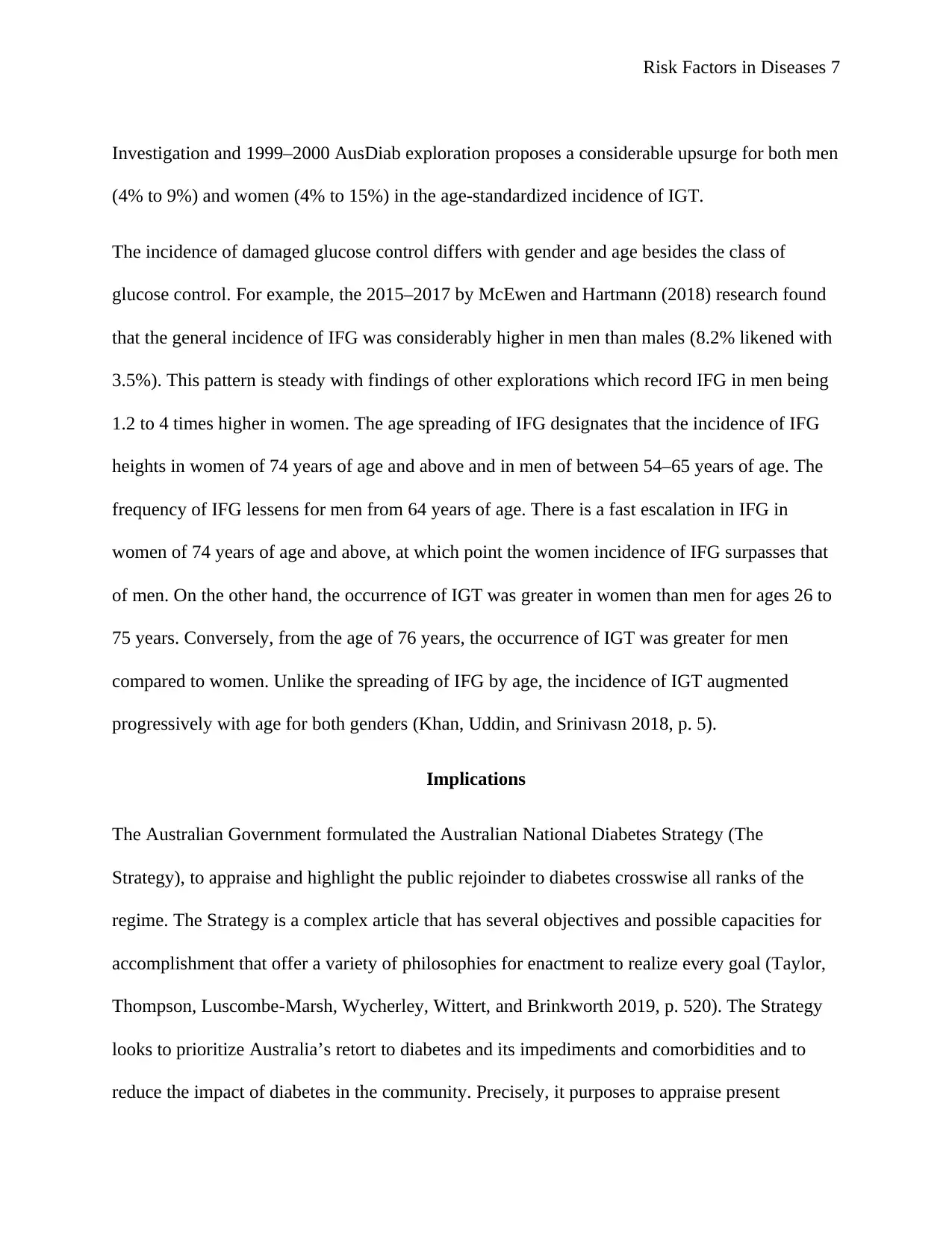
Risk Factors in Diseases 7
Investigation and 1999–2000 AusDiab exploration proposes a considerable upsurge for both men
(4% to 9%) and women (4% to 15%) in the age-standardized incidence of IGT.
The incidence of damaged glucose control differs with gender and age besides the class of
glucose control. For example, the 2015–2017 by McEwen and Hartmann (2018) research found
that the general incidence of IFG was considerably higher in men than males (8.2% likened with
3.5%). This pattern is steady with findings of other explorations which record IFG in men being
1.2 to 4 times higher in women. The age spreading of IFG designates that the incidence of IFG
heights in women of 74 years of age and above and in men of between 54–65 years of age. The
frequency of IFG lessens for men from 64 years of age. There is a fast escalation in IFG in
women of 74 years of age and above, at which point the women incidence of IFG surpasses that
of men. On the other hand, the occurrence of IGT was greater in women than men for ages 26 to
75 years. Conversely, from the age of 76 years, the occurrence of IGT was greater for men
compared to women. Unlike the spreading of IFG by age, the incidence of IGT augmented
progressively with age for both genders (Khan, Uddin, and Srinivasn 2018, p. 5).
Implications
The Australian Government formulated the Australian National Diabetes Strategy (The
Strategy), to appraise and highlight the public rejoinder to diabetes crosswise all ranks of the
regime. The Strategy is a complex article that has several objectives and possible capacities for
accomplishment that offer a variety of philosophies for enactment to realize every goal (Taylor,
Thompson, Luscombe-Marsh, Wycherley, Wittert, and Brinkworth 2019, p. 520). The Strategy
looks to prioritize Australia’s retort to diabetes and its impediments and comorbidities and to
reduce the impact of diabetes in the community. Precisely, it purposes to appraise present
Investigation and 1999–2000 AusDiab exploration proposes a considerable upsurge for both men
(4% to 9%) and women (4% to 15%) in the age-standardized incidence of IGT.
The incidence of damaged glucose control differs with gender and age besides the class of
glucose control. For example, the 2015–2017 by McEwen and Hartmann (2018) research found
that the general incidence of IFG was considerably higher in men than males (8.2% likened with
3.5%). This pattern is steady with findings of other explorations which record IFG in men being
1.2 to 4 times higher in women. The age spreading of IFG designates that the incidence of IFG
heights in women of 74 years of age and above and in men of between 54–65 years of age. The
frequency of IFG lessens for men from 64 years of age. There is a fast escalation in IFG in
women of 74 years of age and above, at which point the women incidence of IFG surpasses that
of men. On the other hand, the occurrence of IGT was greater in women than men for ages 26 to
75 years. Conversely, from the age of 76 years, the occurrence of IGT was greater for men
compared to women. Unlike the spreading of IFG by age, the incidence of IGT augmented
progressively with age for both genders (Khan, Uddin, and Srinivasn 2018, p. 5).
Implications
The Australian Government formulated the Australian National Diabetes Strategy (The
Strategy), to appraise and highlight the public rejoinder to diabetes crosswise all ranks of the
regime. The Strategy is a complex article that has several objectives and possible capacities for
accomplishment that offer a variety of philosophies for enactment to realize every goal (Taylor,
Thompson, Luscombe-Marsh, Wycherley, Wittert, and Brinkworth 2019, p. 520). The Strategy
looks to prioritize Australia’s retort to diabetes and its impediments and comorbidities and to
reduce the impact of diabetes in the community. Precisely, it purposes to appraise present
Paraphrase This Document
Need a fresh take? Get an instant paraphrase of this document with our AI Paraphraser
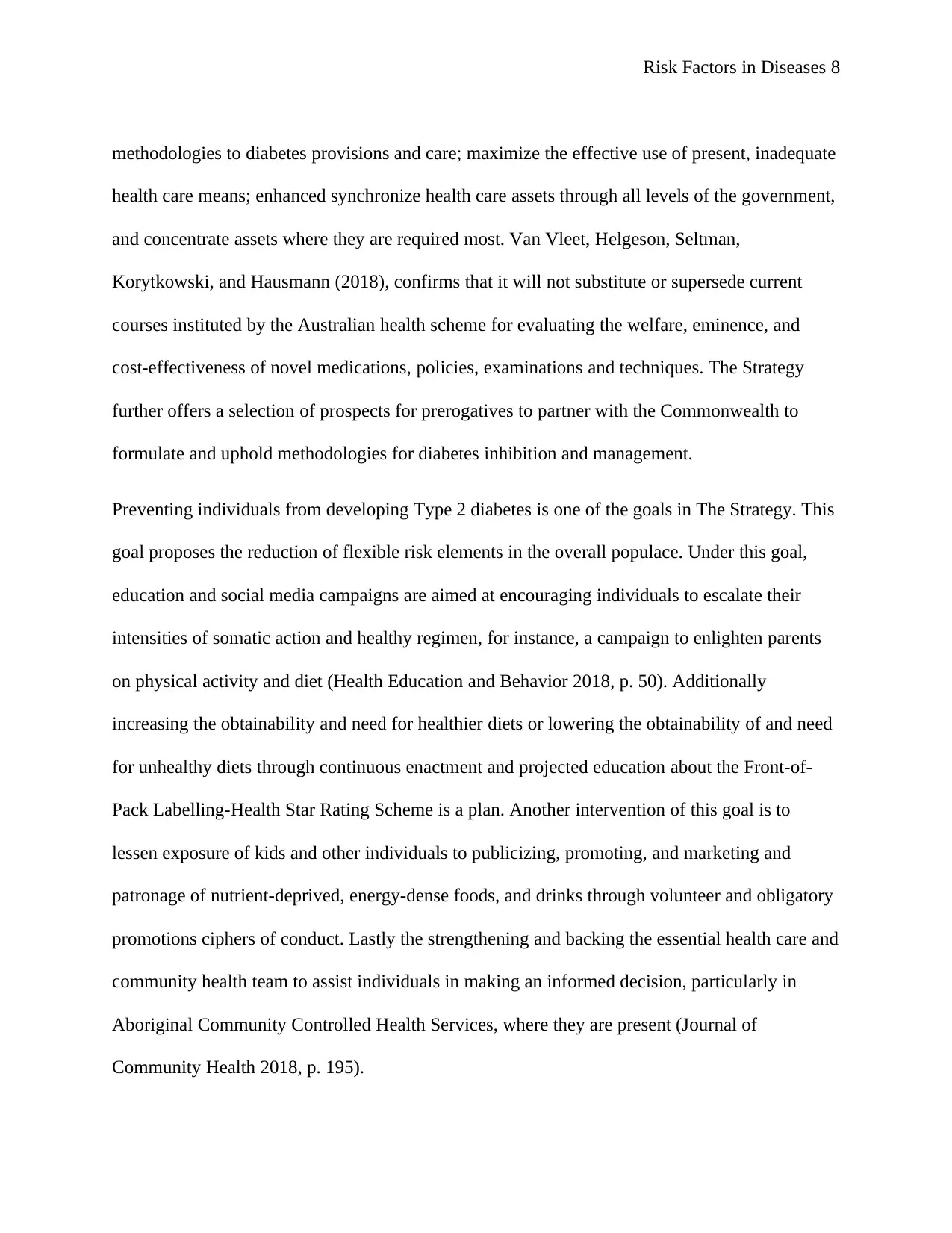
Risk Factors in Diseases 8
methodologies to diabetes provisions and care; maximize the effective use of present, inadequate
health care means; enhanced synchronize health care assets through all levels of the government,
and concentrate assets where they are required most. Van Vleet, Helgeson, Seltman,
Korytkowski, and Hausmann (2018), confirms that it will not substitute or supersede current
courses instituted by the Australian health scheme for evaluating the welfare, eminence, and
cost-effectiveness of novel medications, policies, examinations and techniques. The Strategy
further offers a selection of prospects for prerogatives to partner with the Commonwealth to
formulate and uphold methodologies for diabetes inhibition and management.
Preventing individuals from developing Type 2 diabetes is one of the goals in The Strategy. This
goal proposes the reduction of flexible risk elements in the overall populace. Under this goal,
education and social media campaigns are aimed at encouraging individuals to escalate their
intensities of somatic action and healthy regimen, for instance, a campaign to enlighten parents
on physical activity and diet (Health Education and Behavior 2018, p. 50). Additionally
increasing the obtainability and need for healthier diets or lowering the obtainability of and need
for unhealthy diets through continuous enactment and projected education about the Front-of-
Pack Labelling-Health Star Rating Scheme is a plan. Another intervention of this goal is to
lessen exposure of kids and other individuals to publicizing, promoting, and marketing and
patronage of nutrient-deprived, energy-dense foods, and drinks through volunteer and obligatory
promotions ciphers of conduct. Lastly the strengthening and backing the essential health care and
community health team to assist individuals in making an informed decision, particularly in
Aboriginal Community Controlled Health Services, where they are present (Journal of
Community Health 2018, p. 195).
methodologies to diabetes provisions and care; maximize the effective use of present, inadequate
health care means; enhanced synchronize health care assets through all levels of the government,
and concentrate assets where they are required most. Van Vleet, Helgeson, Seltman,
Korytkowski, and Hausmann (2018), confirms that it will not substitute or supersede current
courses instituted by the Australian health scheme for evaluating the welfare, eminence, and
cost-effectiveness of novel medications, policies, examinations and techniques. The Strategy
further offers a selection of prospects for prerogatives to partner with the Commonwealth to
formulate and uphold methodologies for diabetes inhibition and management.
Preventing individuals from developing Type 2 diabetes is one of the goals in The Strategy. This
goal proposes the reduction of flexible risk elements in the overall populace. Under this goal,
education and social media campaigns are aimed at encouraging individuals to escalate their
intensities of somatic action and healthy regimen, for instance, a campaign to enlighten parents
on physical activity and diet (Health Education and Behavior 2018, p. 50). Additionally
increasing the obtainability and need for healthier diets or lowering the obtainability of and need
for unhealthy diets through continuous enactment and projected education about the Front-of-
Pack Labelling-Health Star Rating Scheme is a plan. Another intervention of this goal is to
lessen exposure of kids and other individuals to publicizing, promoting, and marketing and
patronage of nutrient-deprived, energy-dense foods, and drinks through volunteer and obligatory
promotions ciphers of conduct. Lastly the strengthening and backing the essential health care and
community health team to assist individuals in making an informed decision, particularly in
Aboriginal Community Controlled Health Services, where they are present (Journal of
Community Health 2018, p. 195).
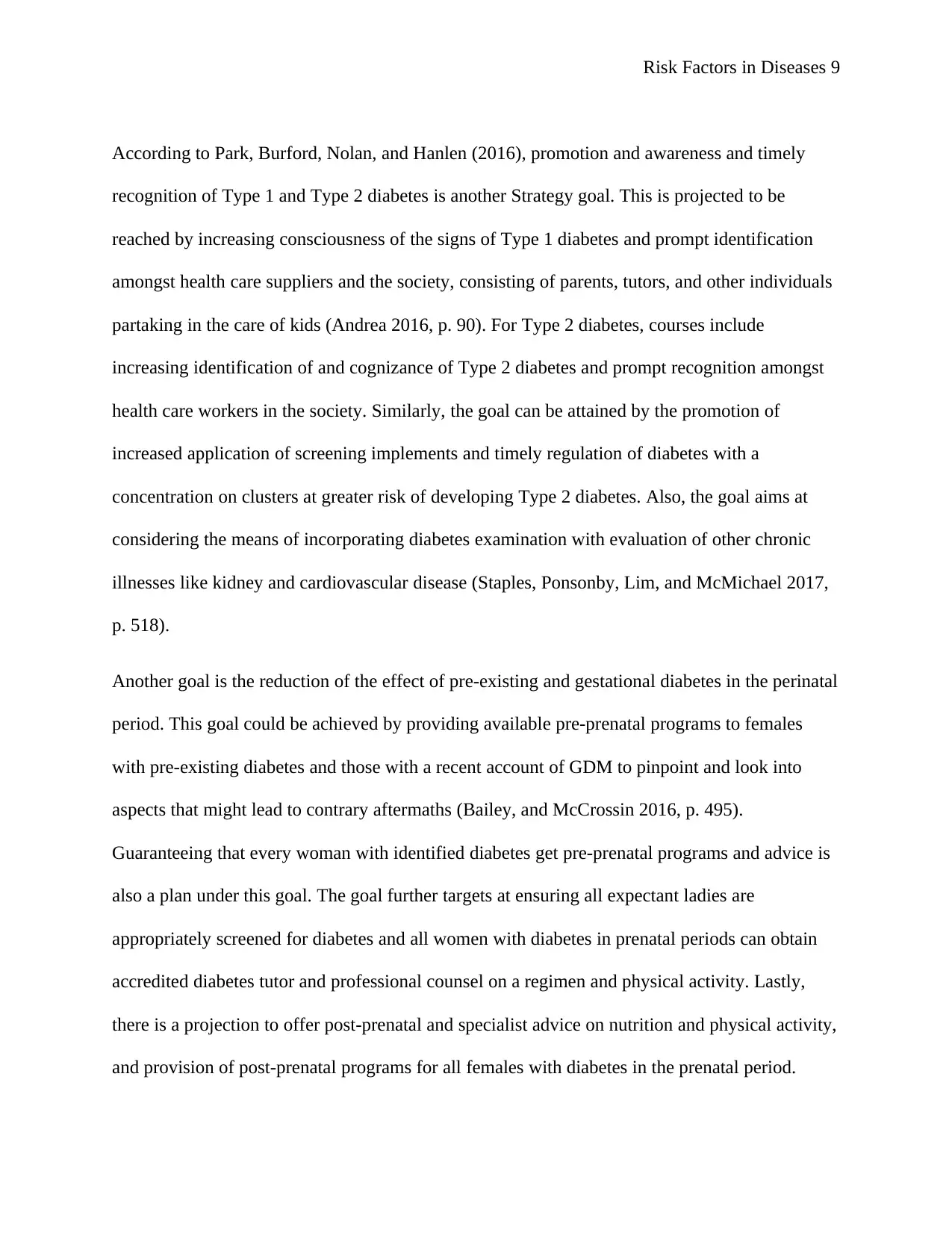
Risk Factors in Diseases 9
According to Park, Burford, Nolan, and Hanlen (2016), promotion and awareness and timely
recognition of Type 1 and Type 2 diabetes is another Strategy goal. This is projected to be
reached by increasing consciousness of the signs of Type 1 diabetes and prompt identification
amongst health care suppliers and the society, consisting of parents, tutors, and other individuals
partaking in the care of kids (Andrea 2016, p. 90). For Type 2 diabetes, courses include
increasing identification of and cognizance of Type 2 diabetes and prompt recognition amongst
health care workers in the society. Similarly, the goal can be attained by the promotion of
increased application of screening implements and timely regulation of diabetes with a
concentration on clusters at greater risk of developing Type 2 diabetes. Also, the goal aims at
considering the means of incorporating diabetes examination with evaluation of other chronic
illnesses like kidney and cardiovascular disease (Staples, Ponsonby, Lim, and McMichael 2017,
p. 518).
Another goal is the reduction of the effect of pre-existing and gestational diabetes in the perinatal
period. This goal could be achieved by providing available pre-prenatal programs to females
with pre-existing diabetes and those with a recent account of GDM to pinpoint and look into
aspects that might lead to contrary aftermaths (Bailey, and McCrossin 2016, p. 495).
Guaranteeing that every woman with identified diabetes get pre-prenatal programs and advice is
also a plan under this goal. The goal further targets at ensuring all expectant ladies are
appropriately screened for diabetes and all women with diabetes in prenatal periods can obtain
accredited diabetes tutor and professional counsel on a regimen and physical activity. Lastly,
there is a projection to offer post-prenatal and specialist advice on nutrition and physical activity,
and provision of post-prenatal programs for all females with diabetes in the prenatal period.
According to Park, Burford, Nolan, and Hanlen (2016), promotion and awareness and timely
recognition of Type 1 and Type 2 diabetes is another Strategy goal. This is projected to be
reached by increasing consciousness of the signs of Type 1 diabetes and prompt identification
amongst health care suppliers and the society, consisting of parents, tutors, and other individuals
partaking in the care of kids (Andrea 2016, p. 90). For Type 2 diabetes, courses include
increasing identification of and cognizance of Type 2 diabetes and prompt recognition amongst
health care workers in the society. Similarly, the goal can be attained by the promotion of
increased application of screening implements and timely regulation of diabetes with a
concentration on clusters at greater risk of developing Type 2 diabetes. Also, the goal aims at
considering the means of incorporating diabetes examination with evaluation of other chronic
illnesses like kidney and cardiovascular disease (Staples, Ponsonby, Lim, and McMichael 2017,
p. 518).
Another goal is the reduction of the effect of pre-existing and gestational diabetes in the perinatal
period. This goal could be achieved by providing available pre-prenatal programs to females
with pre-existing diabetes and those with a recent account of GDM to pinpoint and look into
aspects that might lead to contrary aftermaths (Bailey, and McCrossin 2016, p. 495).
Guaranteeing that every woman with identified diabetes get pre-prenatal programs and advice is
also a plan under this goal. The goal further targets at ensuring all expectant ladies are
appropriately screened for diabetes and all women with diabetes in prenatal periods can obtain
accredited diabetes tutor and professional counsel on a regimen and physical activity. Lastly,
there is a projection to offer post-prenatal and specialist advice on nutrition and physical activity,
and provision of post-prenatal programs for all females with diabetes in the prenatal period.
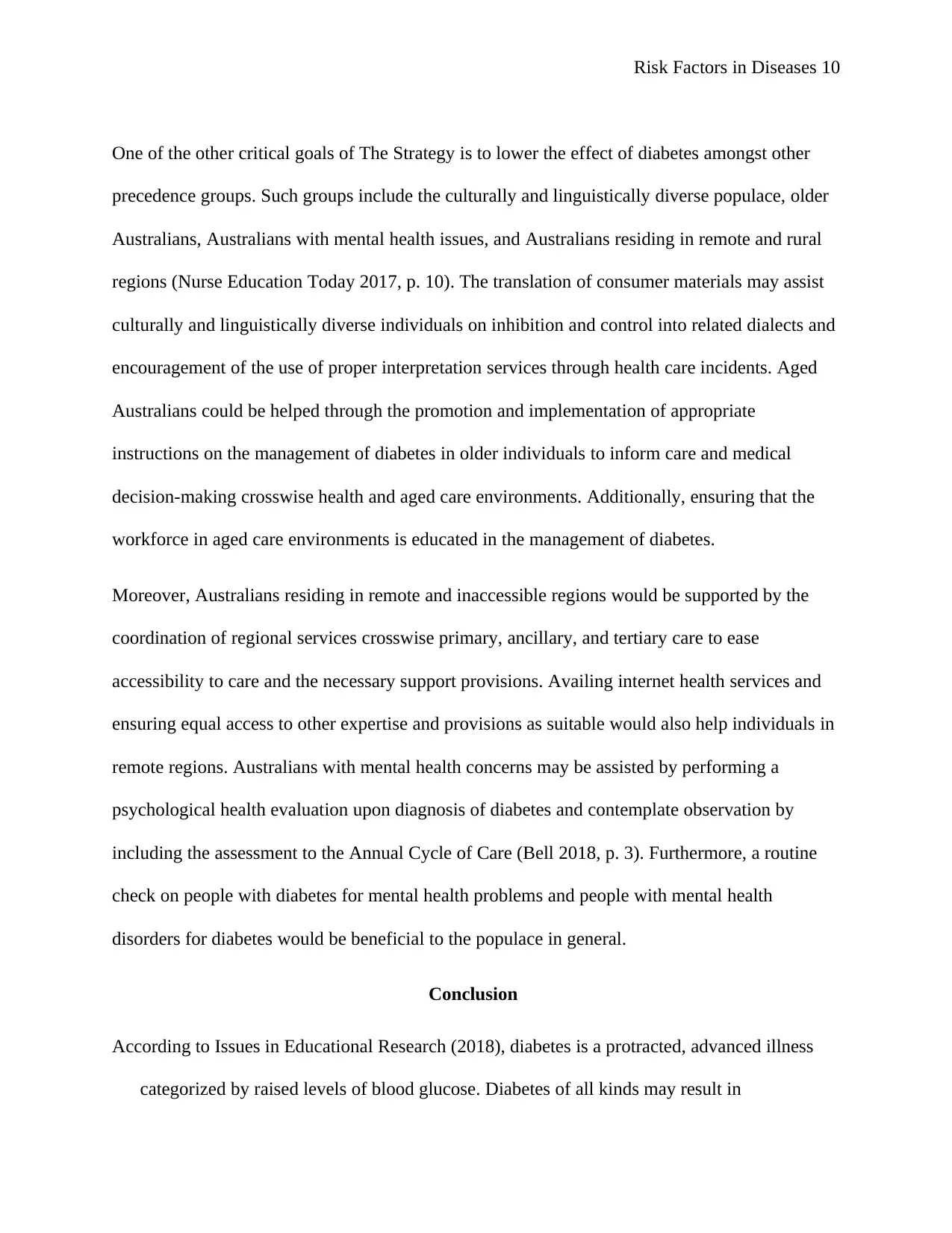
Risk Factors in Diseases 10
One of the other critical goals of The Strategy is to lower the effect of diabetes amongst other
precedence groups. Such groups include the culturally and linguistically diverse populace, older
Australians, Australians with mental health issues, and Australians residing in remote and rural
regions (Nurse Education Today 2017, p. 10). The translation of consumer materials may assist
culturally and linguistically diverse individuals on inhibition and control into related dialects and
encouragement of the use of proper interpretation services through health care incidents. Aged
Australians could be helped through the promotion and implementation of appropriate
instructions on the management of diabetes in older individuals to inform care and medical
decision-making crosswise health and aged care environments. Additionally, ensuring that the
workforce in aged care environments is educated in the management of diabetes.
Moreover, Australians residing in remote and inaccessible regions would be supported by the
coordination of regional services crosswise primary, ancillary, and tertiary care to ease
accessibility to care and the necessary support provisions. Availing internet health services and
ensuring equal access to other expertise and provisions as suitable would also help individuals in
remote regions. Australians with mental health concerns may be assisted by performing a
psychological health evaluation upon diagnosis of diabetes and contemplate observation by
including the assessment to the Annual Cycle of Care (Bell 2018, p. 3). Furthermore, a routine
check on people with diabetes for mental health problems and people with mental health
disorders for diabetes would be beneficial to the populace in general.
Conclusion
According to Issues in Educational Research (2018), diabetes is a protracted, advanced illness
categorized by raised levels of blood glucose. Diabetes of all kinds may result in
One of the other critical goals of The Strategy is to lower the effect of diabetes amongst other
precedence groups. Such groups include the culturally and linguistically diverse populace, older
Australians, Australians with mental health issues, and Australians residing in remote and rural
regions (Nurse Education Today 2017, p. 10). The translation of consumer materials may assist
culturally and linguistically diverse individuals on inhibition and control into related dialects and
encouragement of the use of proper interpretation services through health care incidents. Aged
Australians could be helped through the promotion and implementation of appropriate
instructions on the management of diabetes in older individuals to inform care and medical
decision-making crosswise health and aged care environments. Additionally, ensuring that the
workforce in aged care environments is educated in the management of diabetes.
Moreover, Australians residing in remote and inaccessible regions would be supported by the
coordination of regional services crosswise primary, ancillary, and tertiary care to ease
accessibility to care and the necessary support provisions. Availing internet health services and
ensuring equal access to other expertise and provisions as suitable would also help individuals in
remote regions. Australians with mental health concerns may be assisted by performing a
psychological health evaluation upon diagnosis of diabetes and contemplate observation by
including the assessment to the Annual Cycle of Care (Bell 2018, p. 3). Furthermore, a routine
check on people with diabetes for mental health problems and people with mental health
disorders for diabetes would be beneficial to the populace in general.
Conclusion
According to Issues in Educational Research (2018), diabetes is a protracted, advanced illness
categorized by raised levels of blood glucose. Diabetes of all kinds may result in
Secure Best Marks with AI Grader
Need help grading? Try our AI Grader for instant feedback on your assignments.
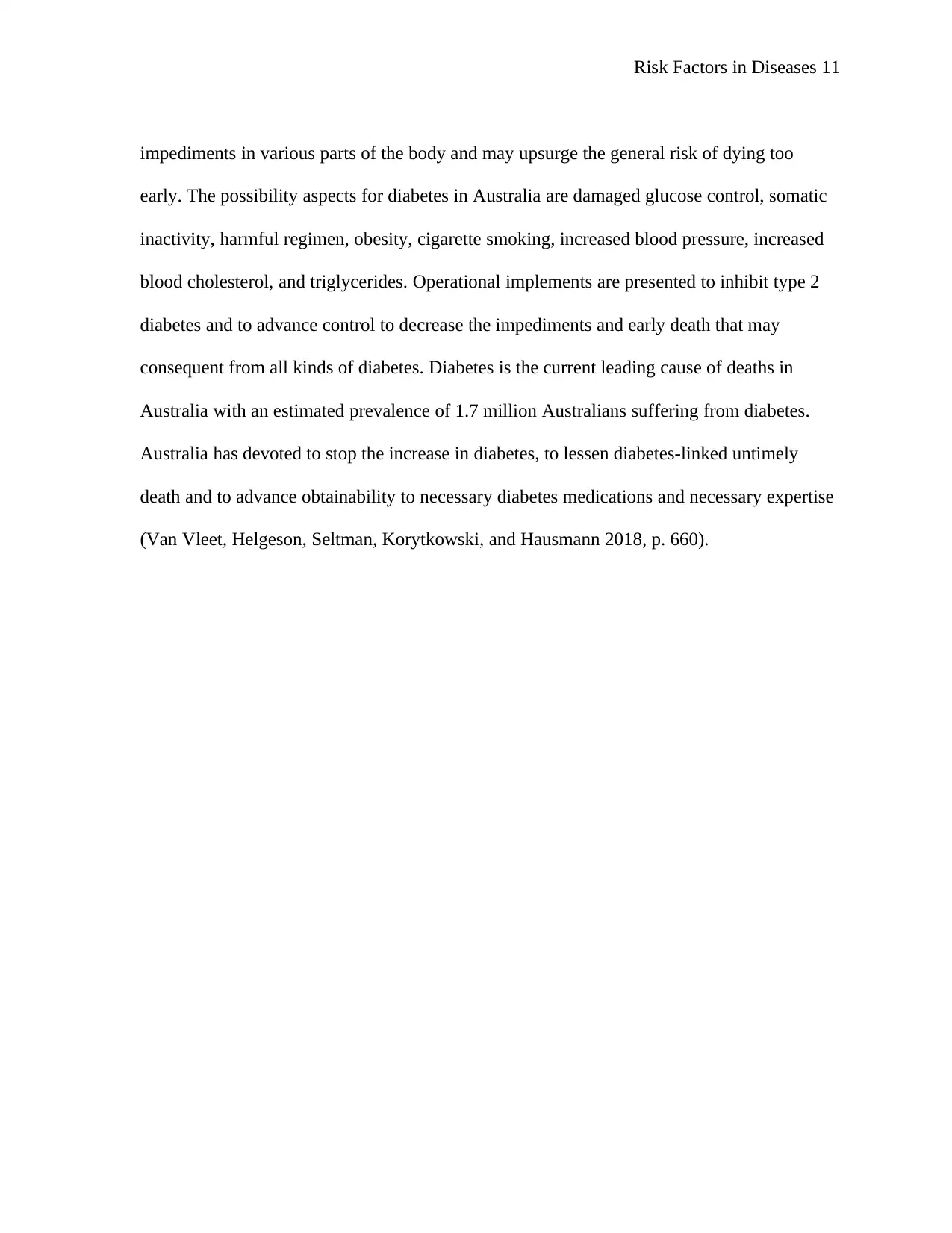
Risk Factors in Diseases 11
impediments in various parts of the body and may upsurge the general risk of dying too
early. The possibility aspects for diabetes in Australia are damaged glucose control, somatic
inactivity, harmful regimen, obesity, cigarette smoking, increased blood pressure, increased
blood cholesterol, and triglycerides. Operational implements are presented to inhibit type 2
diabetes and to advance control to decrease the impediments and early death that may
consequent from all kinds of diabetes. Diabetes is the current leading cause of deaths in
Australia with an estimated prevalence of 1.7 million Australians suffering from diabetes.
Australia has devoted to stop the increase in diabetes, to lessen diabetes-linked untimely
death and to advance obtainability to necessary diabetes medications and necessary expertise
(Van Vleet, Helgeson, Seltman, Korytkowski, and Hausmann 2018, p. 660).
impediments in various parts of the body and may upsurge the general risk of dying too
early. The possibility aspects for diabetes in Australia are damaged glucose control, somatic
inactivity, harmful regimen, obesity, cigarette smoking, increased blood pressure, increased
blood cholesterol, and triglycerides. Operational implements are presented to inhibit type 2
diabetes and to advance control to decrease the impediments and early death that may
consequent from all kinds of diabetes. Diabetes is the current leading cause of deaths in
Australia with an estimated prevalence of 1.7 million Australians suffering from diabetes.
Australia has devoted to stop the increase in diabetes, to lessen diabetes-linked untimely
death and to advance obtainability to necessary diabetes medications and necessary expertise
(Van Vleet, Helgeson, Seltman, Korytkowski, and Hausmann 2018, p. 660).
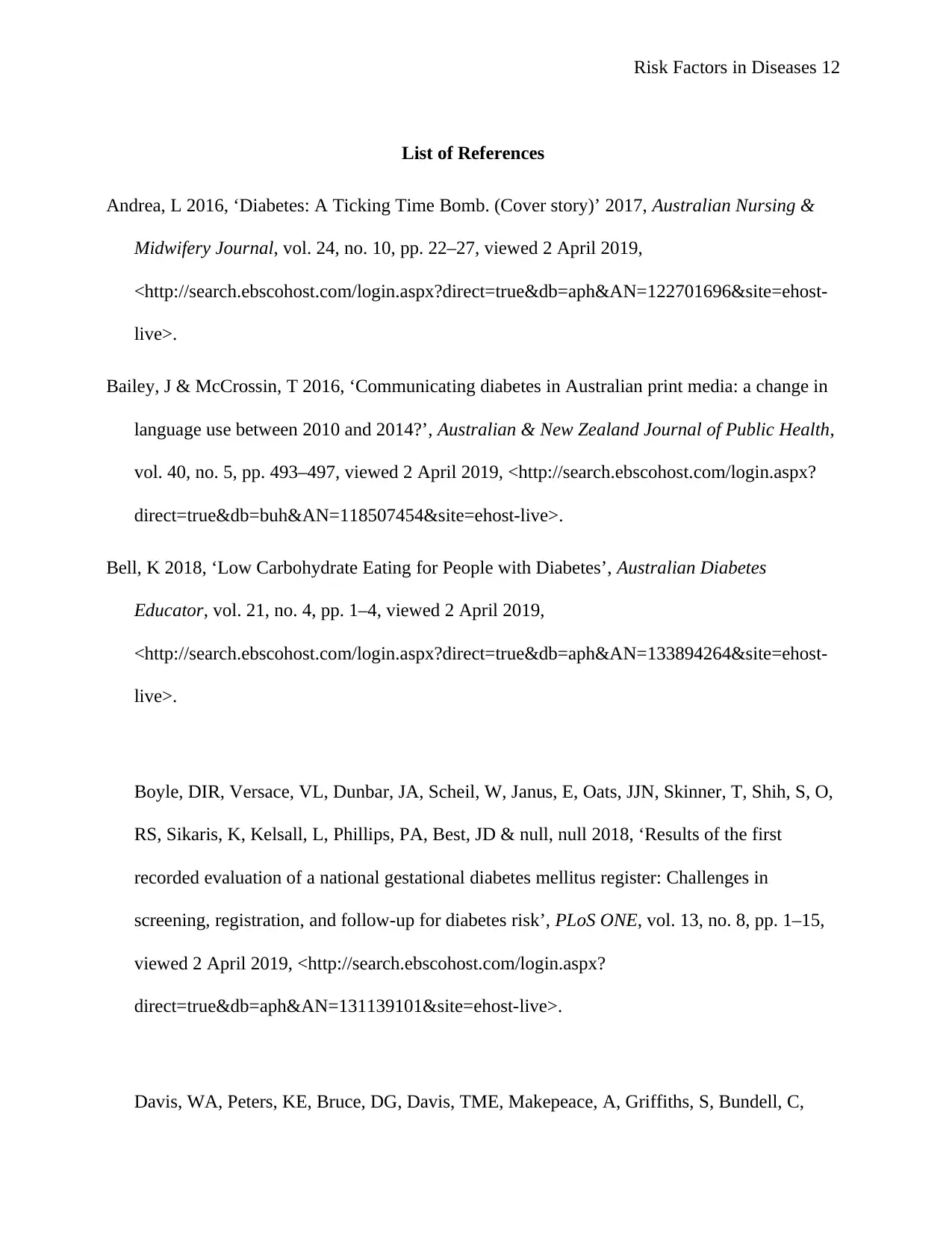
Risk Factors in Diseases 12
List of References
Andrea, L 2016, ‘Diabetes: A Ticking Time Bomb. (Cover story)’ 2017, Australian Nursing &
Midwifery Journal, vol. 24, no. 10, pp. 22–27, viewed 2 April 2019,
<http://search.ebscohost.com/login.aspx?direct=true&db=aph&AN=122701696&site=ehost-
live>.
Bailey, J & McCrossin, T 2016, ‘Communicating diabetes in Australian print media: a change in
language use between 2010 and 2014?’, Australian & New Zealand Journal of Public Health,
vol. 40, no. 5, pp. 493–497, viewed 2 April 2019, <http://search.ebscohost.com/login.aspx?
direct=true&db=buh&AN=118507454&site=ehost-live>.
Bell, K 2018, ‘Low Carbohydrate Eating for People with Diabetes’, Australian Diabetes
Educator, vol. 21, no. 4, pp. 1–4, viewed 2 April 2019,
<http://search.ebscohost.com/login.aspx?direct=true&db=aph&AN=133894264&site=ehost-
live>.
Boyle, DIR, Versace, VL, Dunbar, JA, Scheil, W, Janus, E, Oats, JJN, Skinner, T, Shih, S, O,
RS, Sikaris, K, Kelsall, L, Phillips, PA, Best, JD & null, null 2018, ‘Results of the first
recorded evaluation of a national gestational diabetes mellitus register: Challenges in
screening, registration, and follow-up for diabetes risk’, PLoS ONE, vol. 13, no. 8, pp. 1–15,
viewed 2 April 2019, <http://search.ebscohost.com/login.aspx?
direct=true&db=aph&AN=131139101&site=ehost-live>.
Davis, WA, Peters, KE, Bruce, DG, Davis, TME, Makepeace, A, Griffiths, S, Bundell, C,
List of References
Andrea, L 2016, ‘Diabetes: A Ticking Time Bomb. (Cover story)’ 2017, Australian Nursing &
Midwifery Journal, vol. 24, no. 10, pp. 22–27, viewed 2 April 2019,
<http://search.ebscohost.com/login.aspx?direct=true&db=aph&AN=122701696&site=ehost-
live>.
Bailey, J & McCrossin, T 2016, ‘Communicating diabetes in Australian print media: a change in
language use between 2010 and 2014?’, Australian & New Zealand Journal of Public Health,
vol. 40, no. 5, pp. 493–497, viewed 2 April 2019, <http://search.ebscohost.com/login.aspx?
direct=true&db=buh&AN=118507454&site=ehost-live>.
Bell, K 2018, ‘Low Carbohydrate Eating for People with Diabetes’, Australian Diabetes
Educator, vol. 21, no. 4, pp. 1–4, viewed 2 April 2019,
<http://search.ebscohost.com/login.aspx?direct=true&db=aph&AN=133894264&site=ehost-
live>.
Boyle, DIR, Versace, VL, Dunbar, JA, Scheil, W, Janus, E, Oats, JJN, Skinner, T, Shih, S, O,
RS, Sikaris, K, Kelsall, L, Phillips, PA, Best, JD & null, null 2018, ‘Results of the first
recorded evaluation of a national gestational diabetes mellitus register: Challenges in
screening, registration, and follow-up for diabetes risk’, PLoS ONE, vol. 13, no. 8, pp. 1–15,
viewed 2 April 2019, <http://search.ebscohost.com/login.aspx?
direct=true&db=aph&AN=131139101&site=ehost-live>.
Davis, WA, Peters, KE, Bruce, DG, Davis, TME, Makepeace, A, Griffiths, S, Bundell, C,
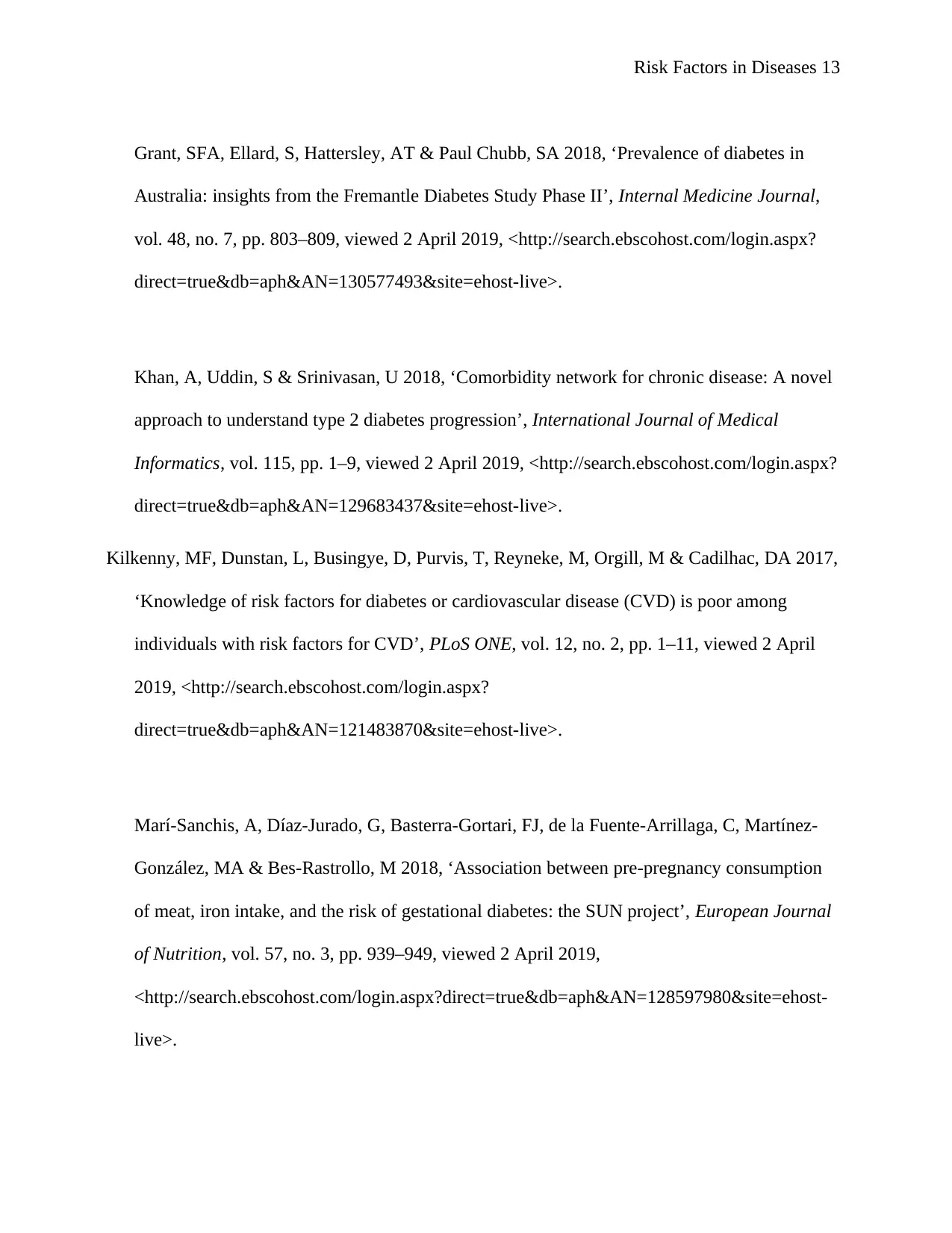
Risk Factors in Diseases 13
Grant, SFA, Ellard, S, Hattersley, AT & Paul Chubb, SA 2018, ‘Prevalence of diabetes in
Australia: insights from the Fremantle Diabetes Study Phase II’, Internal Medicine Journal,
vol. 48, no. 7, pp. 803–809, viewed 2 April 2019, <http://search.ebscohost.com/login.aspx?
direct=true&db=aph&AN=130577493&site=ehost-live>.
Khan, A, Uddin, S & Srinivasan, U 2018, ‘Comorbidity network for chronic disease: A novel
approach to understand type 2 diabetes progression’, International Journal of Medical
Informatics, vol. 115, pp. 1–9, viewed 2 April 2019, <http://search.ebscohost.com/login.aspx?
direct=true&db=aph&AN=129683437&site=ehost-live>.
Kilkenny, MF, Dunstan, L, Busingye, D, Purvis, T, Reyneke, M, Orgill, M & Cadilhac, DA 2017,
‘Knowledge of risk factors for diabetes or cardiovascular disease (CVD) is poor among
individuals with risk factors for CVD’, PLoS ONE, vol. 12, no. 2, pp. 1–11, viewed 2 April
2019, <http://search.ebscohost.com/login.aspx?
direct=true&db=aph&AN=121483870&site=ehost-live>.
Marí-Sanchis, A, Díaz-Jurado, G, Basterra-Gortari, FJ, de la Fuente-Arrillaga, C, Martínez-
González, MA & Bes-Rastrollo, M 2018, ‘Association between pre-pregnancy consumption
of meat, iron intake, and the risk of gestational diabetes: the SUN project’, European Journal
of Nutrition, vol. 57, no. 3, pp. 939–949, viewed 2 April 2019,
<http://search.ebscohost.com/login.aspx?direct=true&db=aph&AN=128597980&site=ehost-
live>.
Grant, SFA, Ellard, S, Hattersley, AT & Paul Chubb, SA 2018, ‘Prevalence of diabetes in
Australia: insights from the Fremantle Diabetes Study Phase II’, Internal Medicine Journal,
vol. 48, no. 7, pp. 803–809, viewed 2 April 2019, <http://search.ebscohost.com/login.aspx?
direct=true&db=aph&AN=130577493&site=ehost-live>.
Khan, A, Uddin, S & Srinivasan, U 2018, ‘Comorbidity network for chronic disease: A novel
approach to understand type 2 diabetes progression’, International Journal of Medical
Informatics, vol. 115, pp. 1–9, viewed 2 April 2019, <http://search.ebscohost.com/login.aspx?
direct=true&db=aph&AN=129683437&site=ehost-live>.
Kilkenny, MF, Dunstan, L, Busingye, D, Purvis, T, Reyneke, M, Orgill, M & Cadilhac, DA 2017,
‘Knowledge of risk factors for diabetes or cardiovascular disease (CVD) is poor among
individuals with risk factors for CVD’, PLoS ONE, vol. 12, no. 2, pp. 1–11, viewed 2 April
2019, <http://search.ebscohost.com/login.aspx?
direct=true&db=aph&AN=121483870&site=ehost-live>.
Marí-Sanchis, A, Díaz-Jurado, G, Basterra-Gortari, FJ, de la Fuente-Arrillaga, C, Martínez-
González, MA & Bes-Rastrollo, M 2018, ‘Association between pre-pregnancy consumption
of meat, iron intake, and the risk of gestational diabetes: the SUN project’, European Journal
of Nutrition, vol. 57, no. 3, pp. 939–949, viewed 2 April 2019,
<http://search.ebscohost.com/login.aspx?direct=true&db=aph&AN=128597980&site=ehost-
live>.
Paraphrase This Document
Need a fresh take? Get an instant paraphrase of this document with our AI Paraphraser
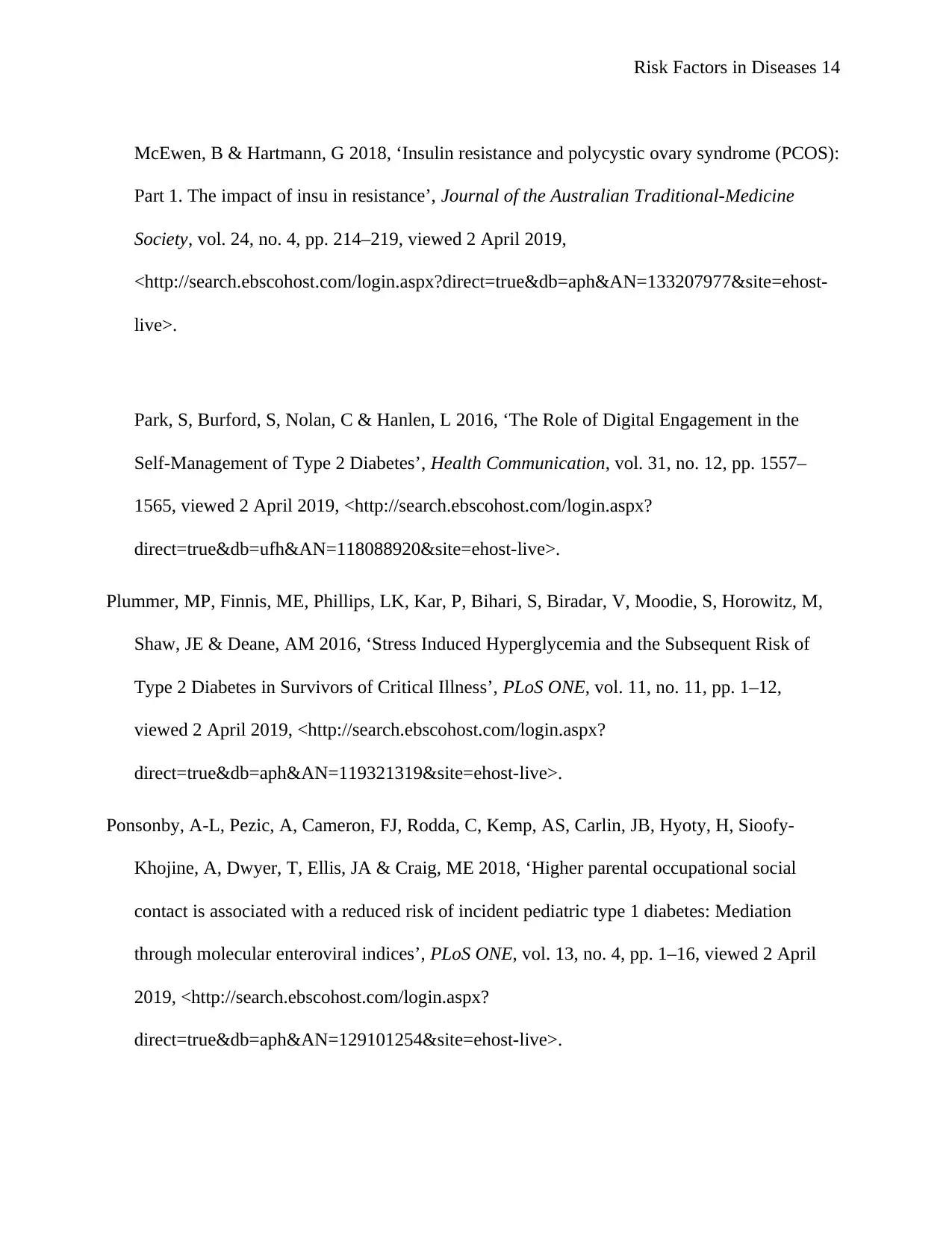
Risk Factors in Diseases 14
McEwen, B & Hartmann, G 2018, ‘Insulin resistance and polycystic ovary syndrome (PCOS):
Part 1. The impact of insu in resistance’, Journal of the Australian Traditional-Medicine
Society, vol. 24, no. 4, pp. 214–219, viewed 2 April 2019,
<http://search.ebscohost.com/login.aspx?direct=true&db=aph&AN=133207977&site=ehost-
live>.
Park, S, Burford, S, Nolan, C & Hanlen, L 2016, ‘The Role of Digital Engagement in the
Self-Management of Type 2 Diabetes’, Health Communication, vol. 31, no. 12, pp. 1557–
1565, viewed 2 April 2019, <http://search.ebscohost.com/login.aspx?
direct=true&db=ufh&AN=118088920&site=ehost-live>.
Plummer, MP, Finnis, ME, Phillips, LK, Kar, P, Bihari, S, Biradar, V, Moodie, S, Horowitz, M,
Shaw, JE & Deane, AM 2016, ‘Stress Induced Hyperglycemia and the Subsequent Risk of
Type 2 Diabetes in Survivors of Critical Illness’, PLoS ONE, vol. 11, no. 11, pp. 1–12,
viewed 2 April 2019, <http://search.ebscohost.com/login.aspx?
direct=true&db=aph&AN=119321319&site=ehost-live>.
Ponsonby, A-L, Pezic, A, Cameron, FJ, Rodda, C, Kemp, AS, Carlin, JB, Hyoty, H, Sioofy-
Khojine, A, Dwyer, T, Ellis, JA & Craig, ME 2018, ‘Higher parental occupational social
contact is associated with a reduced risk of incident pediatric type 1 diabetes: Mediation
through molecular enteroviral indices’, PLoS ONE, vol. 13, no. 4, pp. 1–16, viewed 2 April
2019, <http://search.ebscohost.com/login.aspx?
direct=true&db=aph&AN=129101254&site=ehost-live>.
McEwen, B & Hartmann, G 2018, ‘Insulin resistance and polycystic ovary syndrome (PCOS):
Part 1. The impact of insu in resistance’, Journal of the Australian Traditional-Medicine
Society, vol. 24, no. 4, pp. 214–219, viewed 2 April 2019,
<http://search.ebscohost.com/login.aspx?direct=true&db=aph&AN=133207977&site=ehost-
live>.
Park, S, Burford, S, Nolan, C & Hanlen, L 2016, ‘The Role of Digital Engagement in the
Self-Management of Type 2 Diabetes’, Health Communication, vol. 31, no. 12, pp. 1557–
1565, viewed 2 April 2019, <http://search.ebscohost.com/login.aspx?
direct=true&db=ufh&AN=118088920&site=ehost-live>.
Plummer, MP, Finnis, ME, Phillips, LK, Kar, P, Bihari, S, Biradar, V, Moodie, S, Horowitz, M,
Shaw, JE & Deane, AM 2016, ‘Stress Induced Hyperglycemia and the Subsequent Risk of
Type 2 Diabetes in Survivors of Critical Illness’, PLoS ONE, vol. 11, no. 11, pp. 1–12,
viewed 2 April 2019, <http://search.ebscohost.com/login.aspx?
direct=true&db=aph&AN=119321319&site=ehost-live>.
Ponsonby, A-L, Pezic, A, Cameron, FJ, Rodda, C, Kemp, AS, Carlin, JB, Hyoty, H, Sioofy-
Khojine, A, Dwyer, T, Ellis, JA & Craig, ME 2018, ‘Higher parental occupational social
contact is associated with a reduced risk of incident pediatric type 1 diabetes: Mediation
through molecular enteroviral indices’, PLoS ONE, vol. 13, no. 4, pp. 1–16, viewed 2 April
2019, <http://search.ebscohost.com/login.aspx?
direct=true&db=aph&AN=129101254&site=ehost-live>.
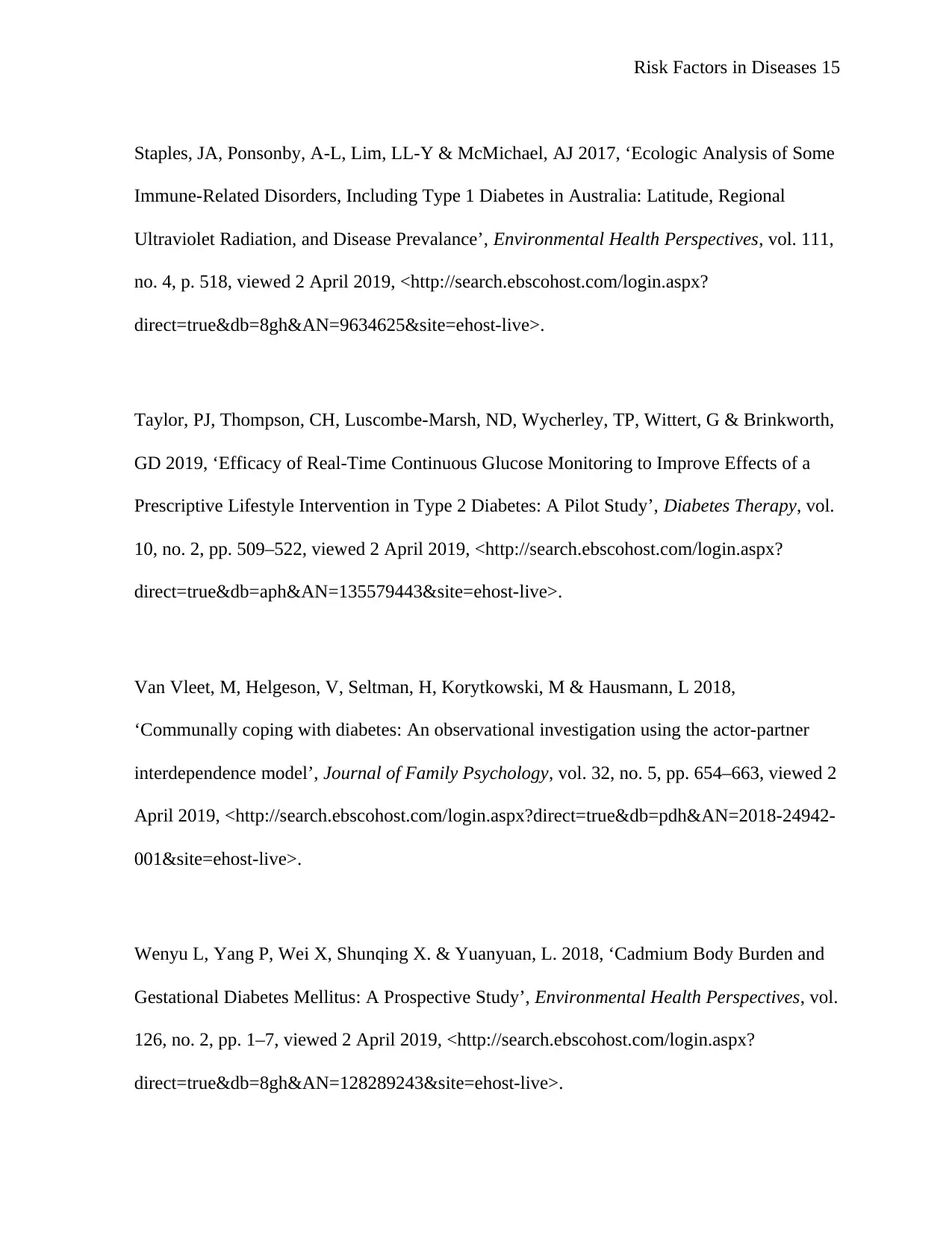
Risk Factors in Diseases 15
Staples, JA, Ponsonby, A-L, Lim, LL-Y & McMichael, AJ 2017, ‘Ecologic Analysis of Some
Immune-Related Disorders, Including Type 1 Diabetes in Australia: Latitude, Regional
Ultraviolet Radiation, and Disease Prevalance’, Environmental Health Perspectives, vol. 111,
no. 4, p. 518, viewed 2 April 2019, <http://search.ebscohost.com/login.aspx?
direct=true&db=8gh&AN=9634625&site=ehost-live>.
Taylor, PJ, Thompson, CH, Luscombe-Marsh, ND, Wycherley, TP, Wittert, G & Brinkworth,
GD 2019, ‘Efficacy of Real-Time Continuous Glucose Monitoring to Improve Effects of a
Prescriptive Lifestyle Intervention in Type 2 Diabetes: A Pilot Study’, Diabetes Therapy, vol.
10, no. 2, pp. 509–522, viewed 2 April 2019, <http://search.ebscohost.com/login.aspx?
direct=true&db=aph&AN=135579443&site=ehost-live>.
Van Vleet, M, Helgeson, V, Seltman, H, Korytkowski, M & Hausmann, L 2018,
‘Communally coping with diabetes: An observational investigation using the actor-partner
interdependence model’, Journal of Family Psychology, vol. 32, no. 5, pp. 654–663, viewed 2
April 2019, <http://search.ebscohost.com/login.aspx?direct=true&db=pdh&AN=2018-24942-
001&site=ehost-live>.
Wenyu L, Yang P, Wei X, Shunqing X. & Yuanyuan, L. 2018, ‘Cadmium Body Burden and
Gestational Diabetes Mellitus: A Prospective Study’, Environmental Health Perspectives, vol.
126, no. 2, pp. 1–7, viewed 2 April 2019, <http://search.ebscohost.com/login.aspx?
direct=true&db=8gh&AN=128289243&site=ehost-live>.
Staples, JA, Ponsonby, A-L, Lim, LL-Y & McMichael, AJ 2017, ‘Ecologic Analysis of Some
Immune-Related Disorders, Including Type 1 Diabetes in Australia: Latitude, Regional
Ultraviolet Radiation, and Disease Prevalance’, Environmental Health Perspectives, vol. 111,
no. 4, p. 518, viewed 2 April 2019, <http://search.ebscohost.com/login.aspx?
direct=true&db=8gh&AN=9634625&site=ehost-live>.
Taylor, PJ, Thompson, CH, Luscombe-Marsh, ND, Wycherley, TP, Wittert, G & Brinkworth,
GD 2019, ‘Efficacy of Real-Time Continuous Glucose Monitoring to Improve Effects of a
Prescriptive Lifestyle Intervention in Type 2 Diabetes: A Pilot Study’, Diabetes Therapy, vol.
10, no. 2, pp. 509–522, viewed 2 April 2019, <http://search.ebscohost.com/login.aspx?
direct=true&db=aph&AN=135579443&site=ehost-live>.
Van Vleet, M, Helgeson, V, Seltman, H, Korytkowski, M & Hausmann, L 2018,
‘Communally coping with diabetes: An observational investigation using the actor-partner
interdependence model’, Journal of Family Psychology, vol. 32, no. 5, pp. 654–663, viewed 2
April 2019, <http://search.ebscohost.com/login.aspx?direct=true&db=pdh&AN=2018-24942-
001&site=ehost-live>.
Wenyu L, Yang P, Wei X, Shunqing X. & Yuanyuan, L. 2018, ‘Cadmium Body Burden and
Gestational Diabetes Mellitus: A Prospective Study’, Environmental Health Perspectives, vol.
126, no. 2, pp. 1–7, viewed 2 April 2019, <http://search.ebscohost.com/login.aspx?
direct=true&db=8gh&AN=128289243&site=ehost-live>.

Risk Factors in Diseases 16
Secure Best Marks with AI Grader
Need help grading? Try our AI Grader for instant feedback on your assignments.

Risk Factors in Diseases 17
1 out of 17
Your All-in-One AI-Powered Toolkit for Academic Success.
+13062052269
info@desklib.com
Available 24*7 on WhatsApp / Email
![[object Object]](/_next/static/media/star-bottom.7253800d.svg)
Unlock your academic potential
© 2024 | Zucol Services PVT LTD | All rights reserved.


